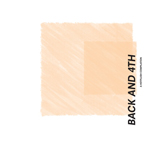|
|
 |
Dusted Reviews
Artist: V/A Album: Back and 4th: A Hotflush Compilation Label: Hotflush Review date: Apr. 5, 2011 |

|
|
|
 |
If “post-dubstep” is getting thrown around as a term more and more, it only underscores that there was a fleeting unity to this strain of electronics just a few years back, a stream that was flowing steady, far away from the main river of pop. As that flow breaks up, “U.K. bass” keeps showing up, even when music that’s derived from Burial and Vex’d and Shackleton isn’t U.K. based. Scuba, the head of Hotflush, is based in Berlin now. Dubstep, the word, has recently undergone semantic bleaching, loosing its reference to a scene with a sound and becoming meme-culture shorthand for epileptic shakes. But then, the long-timers were an experimental enough cohort that it was inevitable their sound would recombine and rediscover its sources. As stateside producers declare their work “dubstep” and go out on the summer rock fest circuit, the fidgety wobbly stuff seems to be coming from names who sound like Eastern European gangsters, evoking a pale-faced clubber who’s worried if he looks good in a yellow track suit. The DJs who’ve moved on use names that evoke National Geographic documentaries.
That’s a major generalization, but the Hotflush stable, which includes Sepalcure, Pangaea and Mount Kimbie, is very much in the latter camp. With one disc of new sides and one disc of recap, Back and 4th follows the setup of 10 Tons Heavy and 5: Five Years of Hyperdub. Play the 10 and 5 and 4th compilations in order, and you’ll hear a different kind of bleaching, as brighter and brighter textures integrate themselves into the murk of slow low-end and late-night echos. At the time of 10 Tons‘ release in 2007, there was a heave-ho that governed the beats. It was more mechanical, more like hip-hop. That heft has moved aside as house and techno have reasserted influence alongside dub and garage.
The lynch pin here is Joy Orbison’s spectral but sexy “Hyph Mngo,” the consensus jam of 2009. If you haven’t heard it, look it up. Peter O’Grady’s secret sauce of clipped vocals and house revelry is explored in some of the strongest tracks on Back and 4th. George FitzGerald’s “We Bilateral,” works with 4/4 thump and techno handclaps, placing straighter-than-usual rhythms in odd frequencies. The thump is so low, it’s more a haze than a beat; regular stuff for dubstep banging, but newly propulsive in the discofied setting.
What differentiates the action here from what was happening a few years back isn’t the rumbles at the low end or taps in the snare range – that continues intact. The evolution has occurred in the middle. Those slippery and warped shocks are absent. That zone is now occupied by organ tones as cozy as flannel. The mystery conjured by reverb tends to be a peripheral effect, with dry and direct sounds taking the foreground. Mount Kimbie, who contributes two tracks, has developed a distinct style by contrasting concrete sampling and washed-out echo. Finger snaps and knee slaps seem like they’re in the room with you, sometimes right by your cheek. That fidelity allows the more processed layers -- backwards keyboards, pinched vocals -- to become intriguingly out of focus, even when the decay is light. They get a surprisingly level of forlornness out of friendly sounds.
The most singularly lovely new track comes from New York’s FaltyDL. “Regret” uses string-section timbres, but the orchestral feel unfurls into a kit drum solo. The crescendo is blunt, the volume on the drums is simply nudged into the red. Passing like a storm, steadier percussion follows in its wake. Crossing the ambient with the jarring, dense interplay with open space, it’s why this stuff caught on in the first place.
By Ben Donnelly
|







